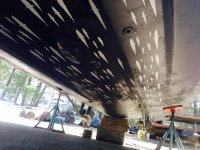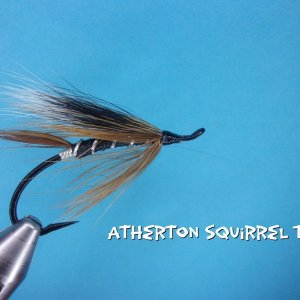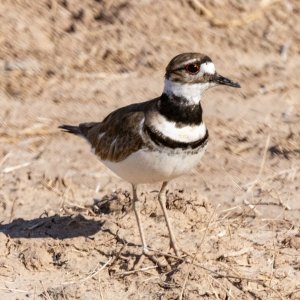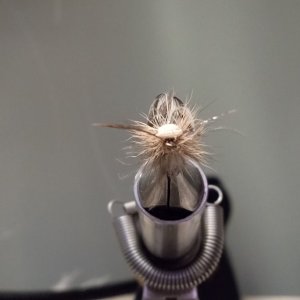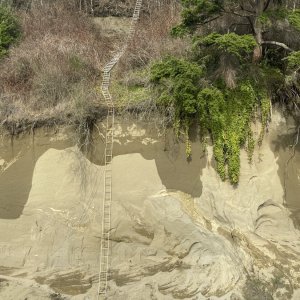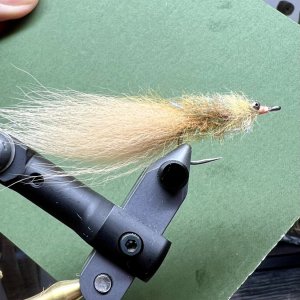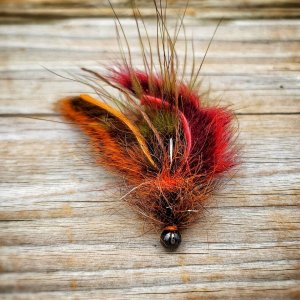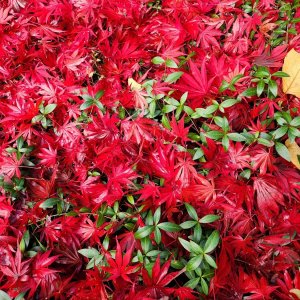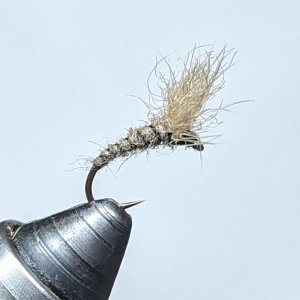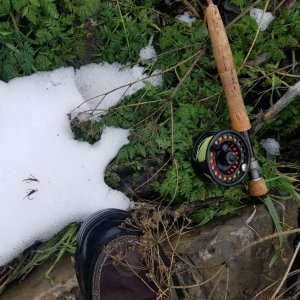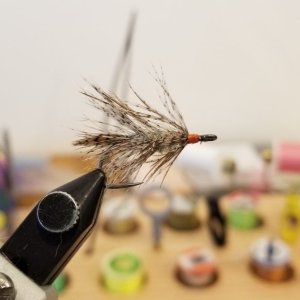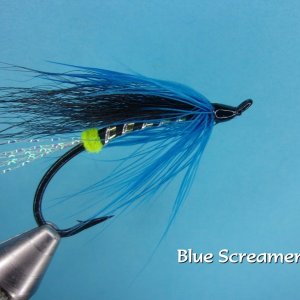Do you think the "flies" would collapse at troll speed though?I thought about this after seeing those tiny slivers of baitfish schooling in 2020. I don't think it necessarily has to be a big, unwieldy, apparatus. Basically a single baitfish pattern tied on a stong hook like a #2 live bait, with up to a half dozen "decoy" flies suspended in front of the main fly on short blood knot tags.
I know it sounds like a mess, but the "decoys" barely need to be more than a few strands of fiber and flash material. A few of those in front of a 2" fly would be nothing to cast on a 12wt. Might play around with this when we get back from the beach.
Edit: Here's a rough sketch. Using Uni-knots for the decoy tags vs blood knots would make them adjustable along the length of the leader, and also allow changing flies. Guessing 15 or even 12# FC would be stiff enough to splay the decoys outward from the leader into a "school".
View attachment 29129
You are using an out of date browser. It may not display this or other websites correctly.
You should upgrade or use an alternative browser.
You should upgrade or use an alternative browser.
Tuna 2022, let the games begin!
- Thread starter SilverFly
- Start date
I wouldn't want to be the one to cast that.
not if you use 200lb testDo you think the "flies" would collapse at troll speed though?
Plus crimps. I wouldn't want try to tie that!not if you use 200lb test
I really don't think so. FC is a very stiff material, and I'm envisioning tags no more than 3-4" long. Probably shorter than that. Also, the decoys would have next to zero drag.Do you think the "flies" would collapse at troll speed though?
mems
Steelhead
Just glue mylar strips on your leader above the fly.I really don't think so. FC is a very stiff material, and I'm envisioning tags no more than 3-4" long. Probably shorter than that. Also, the decoys would have next to zero drag.
That's close to what I'm thinking. These tiny sauries tend to school in tight groups though. More or less in a larger tapered profile.Just glue mylar strips on your leader above the fly.
So I suspect some width is needed for an accurate "school" imitation. These sauries are tiny so the decoys, whether mylar strips or mini hook less flies, would be mere wisps of material. No crimps or heavy leader needed.
I did have some leader and flies with me. Here's a really crappy 2 decoy mockup using 20# FC and some fibers trimmed from a larger fly. The 20# FC is seriously "springy" and I doubt would flatten at typically trolling speeds.
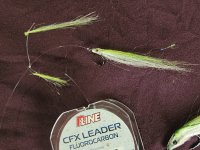
Proper decoys tied on hook shanks and connected to loops on the tag ends should swing free and track well - unlike these granny-knotted fiber bundles.
I dunno. Looks like crap here but still think this would work.
Last edited:
You're a mad scientist! That's so awesome.That's close to what I'm thinking. These tiny sauries tend to school in tight groups though. More or less in a larger tapered profile.
So I suspect some width is needed for an accurate "school" imitation. These sauries are tiny so the decoys, whether mylar strips or mini hook less flies, would be mere wisps of material. No crimps or heavy leader needed.
I did have some leader and flies with me. Here's a really crappy 2 decoy mockup using 20# FC and some fibers trimmed from a larger fly. The 20# FC is seriously "springy" and I doubt would flatten at typically trolling speeds.
View attachment 29141
Proper decoys tied on hook shanks and connected to loops on the tag ends should swing free and track well - unlike these granny-knotted fiber bundles.
I dunno. Looks like crap here but still think this would work.
There's only one thing I dislike as much as Xraps, and that's spreaders 
mems
Steelhead
Nice idea on the fish decals on the hull. Don't know if it would be so good with lots of marlin around.
 Silverfly, Guy found this on E-bay you could use, but I would just cut a strip of mylar and glue it to the leader above the fly
Silverfly, Guy found this on E-bay you could use, but I would just cut a strip of mylar and glue it to the leader above the fly

OSP Soft Lure Mylar Minnow 2.5 Inches MW-009 (2361) 4582373952361 | eBay
Find many great new & used options and get the best deals for OSP Soft Lure Mylar Minnow 2.5 Inches MW-009 (2361) at the best online prices at eBay! Free shipping for many products!
www.ebay.com
Thanks. I've got a pretty good idea of what I want to try when I get back to my tying bench.Nice idea on the fish decals on the hull. Don't know if it would be so good with lots of marlin around.
Silverfly, Guy found this on E-bay you could use, but I would just cut a strip of mylar and glue it to the leader above the fly
OSP Soft Lure Mylar Minnow 2.5 Inches MW-009 (2361) 4582373952361 | eBay
Find many great new & used options and get the best deals for OSP Soft Lure Mylar Minnow 2.5 Inches MW-009 (2361) at the best online prices at eBay! Free shipping for many products!www.ebay.com
We got one it’s called fly fishing. You got to be a little odd, to think of all this shit that we come up with and advance this fishery.You guys need a hobby.
edit- N/M, this was a useless post, but here’s something to chew on—the sea surface temperature does not necessarily reflect the temperature or even the same chlorophyll levels as at what is at depth, and the albacore can be down there in some water more to their liking. At that point, can trolling bring them up? Are we running over and past catchable tuna?
I am starting to nerd out. In case you want to join me here are some videos -
I am starting to nerd out. In case you want to join me here are some videos -
Last edited:
edit- N/M, this was a useless post, but here’s something to chew on—the sea surface temperature does not necessarily reflect the temperature or even the same chlorophyll levels as at what is at depth, and the albacore can be down there in some water more to their liking. At that point, can trolling bring them up? Are we running over and past catchable tuna?
I am starting to nerd out. In case you want to join me here are some videos -
I've long thought surface temp was way over emphasized by albacore anglers. I'm no scientist but I always wondered how important sea temp at the surface could be for a fish that can and does go quite deep when they want. The places I've seen and caught tuna, especially the last two years, really helped me believe that even stronger.
The icing on the cake, for me, is that I've fished this entire tuna season without a working sea temp gage lol.
Ultimately I think that sort of stuff is useful for getting an idea of where they might be, but in the end I am learning to trust what I'm actually seeing with my eyes in terms of "sign", trust my instincts, and not be as worried about where they "should" be.
I find that tuna water looks like tuna water, and while temp and color definitely plays a part, there is far more to it than that.
Wha?!The icing on the cake, for me, is that I've fished this entire tuna season without a working sea temp gage lol.
Wha?!
Yup, sea temp comes from the transducer and mine is dead/dying. Most of the time it reads nothing at all, occasionally popping on for a few seconds with a temp ranging from 65-173 lol. It's been a great source of entertainment for me this season.
Sat shots give me enough info to go on, beyond that I'm finding I truly don't need real time temp.
Last edited:
When that gage gets to 75F let me know I really need a warm ocean swim.Yup, sea temp comes from the transducer and mine is dead/dying. Most of the time it reads nothing at all, occasionally popping on for a few seconds with a temp ranging from 65-173 lol. It's been a great source of entertainment for me this season.
Sat shots give me enough info to go on, beyond that I'm finding I truly don't need real time temp.
The sea surface temperatures have been quite anomalous this past week. When I checked yesterday, after @Nick Clayton's post, I checked the temperatures on the Tuna Fishers product offered by NANOOS. There was some cool water (i.e., upwelling) along the Southern Oregon and Northern California coasts. But off Washington, there was warm surface water all the way to the coast (warm meaning in the lower 60's). Even today with a storm offshore and north-westerly winds, you can see how tight the warm surface water is to the Washington coast (with some upwelling off Vancouver Island and starting off the Washington coast).
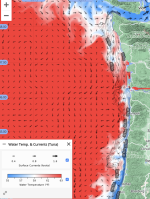
This looks more like downwelling, when winds from the south / southwest, push warm water toward the coast. WA often experiences downwelling in the winter; downwelling is associated with low productivity because it is pushing low-nutrient offshore water toward the coast. Our winter downwelling is one of the reasons that our salmon don't hang offshore in the winter but migrate up to Alaska where other factors support productivity while Oregon and California salmonids find abundant food along the coast because of a longer upwelling window. [During upwelling, winds from the north push warm surface water offshore and draw up cooler, nutrient-rich water to the surface.].
Of course, this image is just showing surface temperatures from satellites. Holding salinity relatively constant (see this diagram that expresses the relationship among salinity and temperature on density), you can have warm water (less dense) sitting over colder water (more dense) but you cannot have colder water sitting over warmer water.
Steve

This looks more like downwelling, when winds from the south / southwest, push warm water toward the coast. WA often experiences downwelling in the winter; downwelling is associated with low productivity because it is pushing low-nutrient offshore water toward the coast. Our winter downwelling is one of the reasons that our salmon don't hang offshore in the winter but migrate up to Alaska where other factors support productivity while Oregon and California salmonids find abundant food along the coast because of a longer upwelling window. [During upwelling, winds from the north push warm surface water offshore and draw up cooler, nutrient-rich water to the surface.].
Of course, this image is just showing surface temperatures from satellites. Holding salinity relatively constant (see this diagram that expresses the relationship among salinity and temperature on density), you can have warm water (less dense) sitting over colder water (more dense) but you cannot have colder water sitting over warmer water.
Steve
Steve for dummies like me what does the do to our albacore fishing next week, if the weather doesn’t put us in the camp grounds that is?The sea surface temperatures have been quite anomalous this past week. When I checked yesterday, after @Nick Clayton's post, I checked the temperatures on the Tuna Fishers product offered by NANOOS. There was some cool water (i.e., upwelling) along the Southern Oregon and Northern California coasts. But off Washington, there was warm surface water all the way to the coast (warm meaning in the lower 60's). Even today with a storm offshore and north-westerly winds, you can see how tight the warm surface water is to the Washington coast (with some upwelling off Vancouver Island and starting off the Washington coast).
View attachment 29378
This looks more like downwelling, when winds from the south / southwest, push warm water toward the coast. WA often experiences downwelling in the winter; downwelling is associated with low productivity because it is pushing low-nutrient offshore water toward the coast. Our winter downwelling is one of the reasons that our salmon don't hang offshore in the winter but migrate up to Alaska where other factors support productivity while Oregon and California salmonids find abundant food along the coast because of a longer upwelling window. [During upwelling, winds from the north push warm surface water offshore and draw up cooler, nutrient-rich water to the surface.].
Of course, this image is just showing surface temperatures from satellites. Holding salinity relatively constant (see this diagram that expresses the relationship among salinity and temperature on density), you can have warm water (less dense) sitting over colder water (more dense) but you cannot have colder water sitting over warmer water.
Steve

